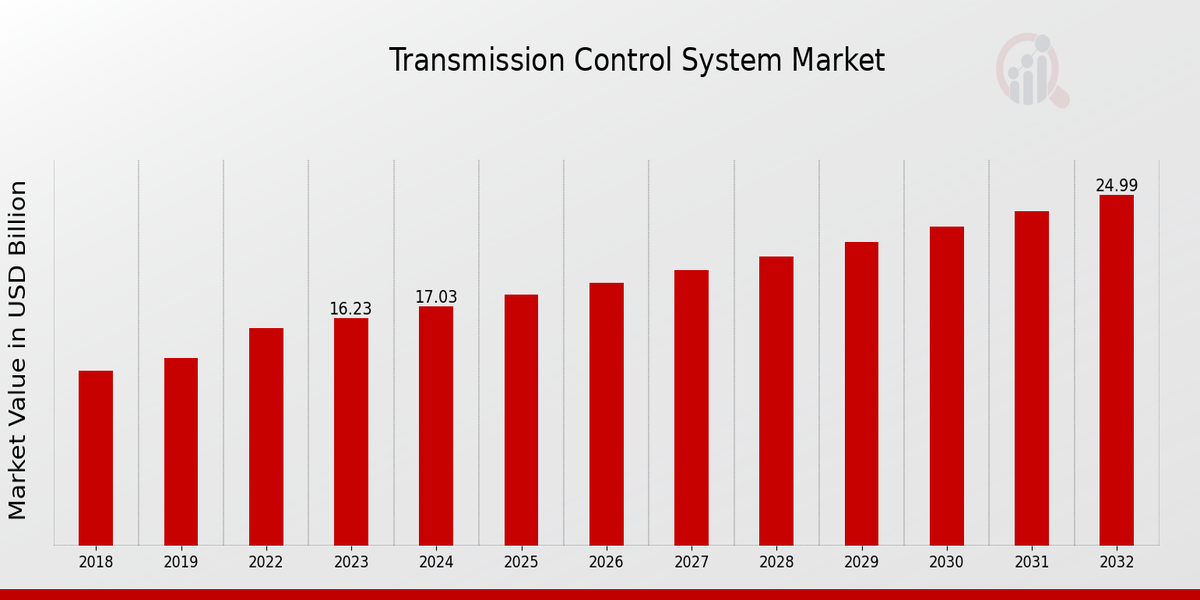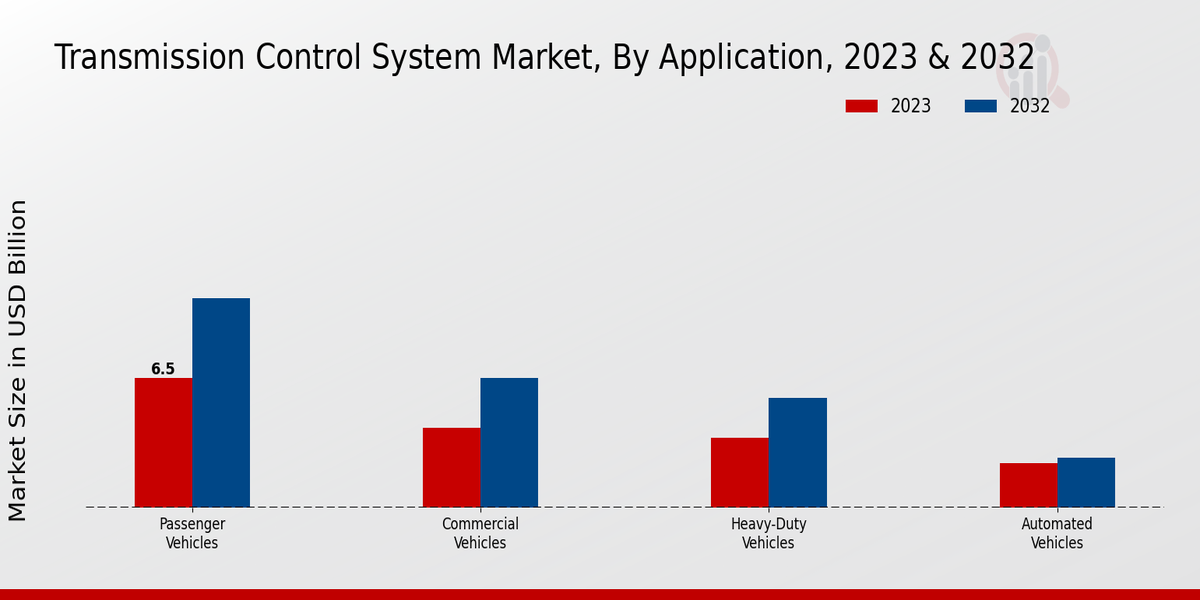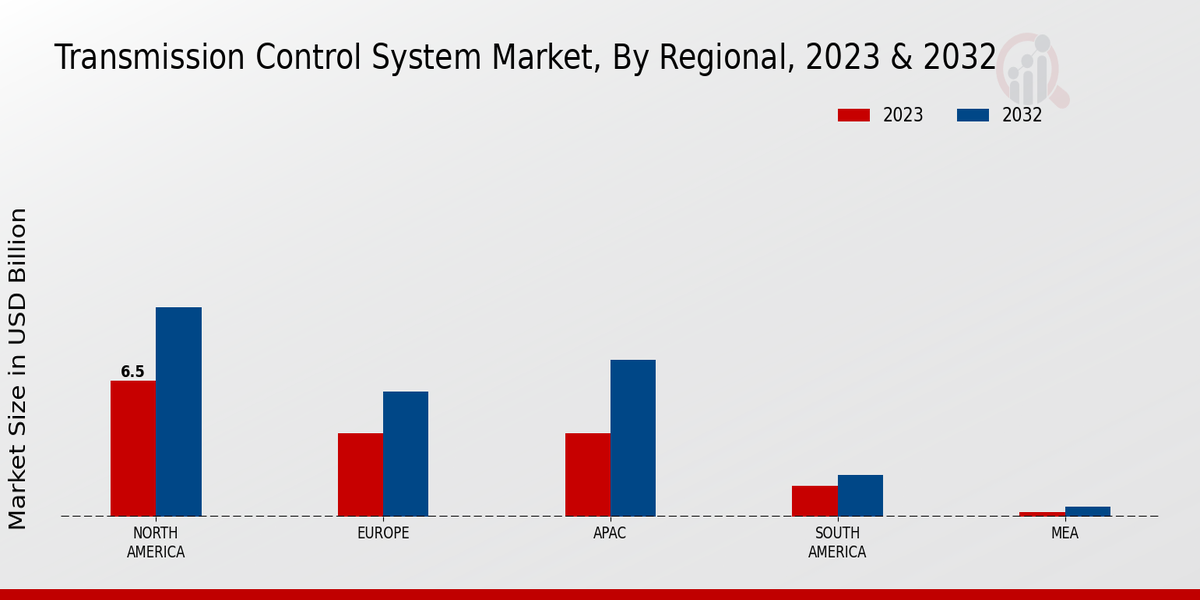Global Transmission Control System Market Overview
As per MRFR analysis, the Transmission Control System Market Size was estimated at 15.47 (USD Billion) in 2022.
The Transmission Control System Market is expected to grow from 16.23 (USD Billion) in 2023 to 25.0 (USD Billion) by 2032. The Transmission Control System Market CAGR (growth rate) is expected to be around 4.91% during the forecast period (2024 - 2032).
Key Transmission Control System Market Trends Highlighted
The increasing need for dependable and efficient transmission systems across various sectors is driving a significant expansion in the Transmission Control System Market.
The growing popularity of electric cars, which need sophisticated transmissions to operate at their best, and strict government laws requiring higher safety and fuel economy criteria are major market drivers.
The need for these systems is also significantly shaped by the development of autonomous driving technologies and the increasing Internet of Things connectivity of automobiles. The development of intelligent transmission systems that can interface with digital platforms for real-time data analysis is one of the market's many noteworthy opportunities.
In order to satisfy the changing demands of both conventional and electric vehicles, manufacturers can concentrate on developing next-generation transmission control units. Businesses who develop innovative ways to improve control and efficiency in these systems will probably gain a sizable portion of the market as electric and hybrid vehicles proliferate.
Recent trends indicate a shift towards energy-efficient solutions, wherein manufacturers are investing in research and development to create lighter, more compact transmission control systems. The use of artificial intelligence and machine learning to enhance predictive maintenance and improve system reliability is gaining traction.
Moreover, collaborations between automotive technology companies and software developers are on the rise, leading to systems that are not only efficient but also adaptable to other vehicle platforms. As these advancements continue, the market is expected to transform, addressing the urgent needs of modern transportation and contributing to a more sustainable future.

Source: Primary Research, Secondary Research, MRFR Database and Analyst Review
Transmission Control System Market Drivers
Increasing Demand for Automatic Transmission Systems
The rise in demand for automatic transmission systems drives the Transmission Control System Market significantly. As consumers increasingly prefer vehicles with advanced features that provide ease of driving, the automatic transmission system has become a preferred choice.
This shift is primarily fueled by the desire for enhanced comfort and convenience during driving. Additionally, the growing trend towards electric and hybrid vehicles contributes to this demand, as these vehicles often come equipped with sophisticated transmission control systems that optimize performance and efficiency.
Furthermore, auto manufacturers are investing heavily in research and development to innovate and improve automatic transmission technologies, which creates a competitive edge in the market. The integration of advanced electronics in transmission control systems enhances the vehicle's overall performance, leading to better fuel efficiency and reduced emissions.
This focus on sustainable and efficient transportation solutions aligns with global efforts to combat climate change and drive towards greener technologies.
Consequently, as automatic transmission systems gain traction, the market for transmission control systems is poised for substantial growth due to their critical role in the automotive sector.
Technological Advancements in Automotive Electronics
Technological advancements in automotive electronics play a crucial role in propelling the Transmission Control System Market forward. With the advent of new technologies, there has been an increased focus on the development of smarter transmission systems that can adapt to varying driving conditions.
Innovations such as adaptive transmission control, shift-by-wire systems, and the integration of artificial intelligence in vehicle dynamics are enhancing the capabilities of transmission control systems.
These improvements lead to better engine performance, increased fuel efficiency, and reduced environmental impact, which are becoming increasingly important to consumers and regulatory bodies alike. As these technologies continue to evolve, they create new opportunities for manufacturers to capture a larger market share by offering innovative and efficient transmission solutions.
Growing Vehicle Production and Sales
The growth in global vehicle production and sales is a significant driver for the Transmission Control System Market. As more vehicles are manufactured, the need for robust transmission solutions becomes imperative.
Manufacturers are expanding their production capacities to meet increasing consumer demand, which ultimately leads to higher installation rates of transmission control systems. Additionally, emerging markets are witnessing a surge in vehicle ownership, further contributing to the expansion of the automotive sector.
As economic conditions improve and middle-class populations rise in these regions, the demand for personal and commercial vehicles is expected to increase substantially. This trend directly impacts the transmission control system market, as more vehicles will necessitate effective and reliable transmission management systems.
Transmission Control System Market Segment Insights
Transmission Control System Market Application Insights
The Application segment of the Transmission Control System Market revealed significant insights into the industry, showcasing a robust framework for growth across various vehicle types.
In 2023, the market for Passenger Vehicles was valued at 6.5 USD Billion and is projected to reach 10.5 USD Billion by 2032, demonstrating a strong growth trajectory. This segment dominated the landscape due to the increasing demand for personal mobility solutions and the rising number of passenger vehicles on the road globally.
The growing trend towards electric vehicles also enhanced the relevance of transmission control systems in this segment, making it a critical area in the market.
The Commercial Vehicles segment held a valuation of 4.0 USD Billion in 2023, expected to grow to 6.5 USD Billion by 2032. This segment is driven by a surge in urbanization and e-commerce, leading to higher demand for logistics and transportation solutions.
Commercial vehicles were essential for supply chain operations, making the need for efficient transmission control systems paramount in optimizing fuel consumption and operational efficiency.
Heavy-duty vehicles exhibited a market value of 3.5 USD Billion in 2023, projected to escalate to 5.5 USD Billion by 2032. This segment was significant due to the essential role heavy-duty vehicles played in industries such as construction, mining, and freight transport. Their robust performance requirements necessitated advanced transmission control systems to enhance power delivery and improve overall vehicle handling, making this a vital segment of the market.
Lastly, the Automated Vehicles segment, which was increasingly gaining traction in the automotive industry, is valued at 2.23 USD Billion in 2023, with an expected increase to 2.5 USD Billion by 2032. While this segment was comparatively smaller, its significance cannot be understated as automated driving technology progresses.
Advances in automation required sophisticated transmission control systems to enable seamless integration between vehicle dynamics and control algorithms. The growing trend towards autonomous driving offers considerable opportunities in this segment for advancements in technology and innovation.
Overall, the Transmission Control System Market segmentation illustrated a dynamic interplay across different vehicle applications, revealing vital growth drivers, trends, and challenges necessary for stakeholders in the industry. Key market statistics and valuations throughout the segments reflected the ongoing evolution within the automotive space, encouraging investment and development in advanced transmission control systems tailored to specific vehicle needs.

Source: Primary Research, Secondary Research, MRFR Database and Analyst Review
Transmission Control System Market Transmission Type Insights
The market segmentation is driven by the increasing adoption of Automatic Transmission systems, which offer enhanced driving convenience and fuel efficiency. Although Manual Transmission remains popular among performance enthusiasts for its control, the trend is shifting towards more automated solutions.
Semi-automatic transmission has gained traction due to its ability to combine the best features of both automatic and manual systems, providing flexibility and improved performance in diverse driving conditions.
The growth of this segment is supported by factors such as the rising consumer preference for fuel-efficient vehicles, stringent regulations regarding emissions, and the ongoing advancements in automotive technology that enhance overall vehicle performance and safety.
Insights from Transmission Control System Market data suggest that as the automotive industry continues to innovate, the demand for these transmission types will play a crucial role in shaping market dynamics in the coming years. Overall, understanding Transmission Control System Market statistics and segmentation is essential to identify growth opportunities within this evolving industry.
Transmission Control System Market Technology Insights
The market is influenced heavily by technological advancements, focusing on enhancing vehicle performance and efficiency. Within this landscape, the Electronic Control Unit plays a pivotal role, serving as the brain of modern transmission systems and enabling sophisticated functionalities.
Meanwhile, the Hydraulic Control System remains significant due to its reliability and effectiveness in maintaining optimal transmission fluid levels under varying conditions.
Additionally, the Mechanical Control System is crucial for traditional vehicle designs and caters to a sizable consumer base. The market demonstrates a growing interest in fuel-efficient solutions and the integration of automation technologies, highlighting opportunities for innovation and expansion.
However, the market faces challenges, including the need for substantial investment in research and development and fluctuating raw material costs. Overall, the insight from the Transmission Control System Market data reflects a dynamic industry landscape, with a continuous push towards modernization and enhanced performance across various automotive applications.
Transmission Control System Market End Use Insights
The Transmission Control System Market demonstrates significant potential within the End Use segment, which comprises both OEM and Aftermarket categories.
The OEM segment plays a critical role, as it supplies new vehicles with integrated transmission control systems, showcasing the market's reliance on innovation and technology from manufacturers. This sector is vital, as it often drives the latest advancements and features that enhance vehicle performance.
Conversely, the Aftermarket segment supports the ongoing maintenance and upgrade of existing systems, reflecting a substantial share of the overall market, as vehicle longevity and optimization efforts become priorities among consumers.
These two segments together form a robust framework for the transmission control system industry, supported by trends in automotive electrification and automation, which represent significant growth drivers. However, challenges such as supply chain disruptions and fluctuating material costs may impact overall performance in the near term.
Despite this, the market remains poised for expansion, creating opportunities for providers in both OEM and Aftermarket sectors as demand for enhanced driving experiences continues to rise.
Transmission Control System Market Regional Insights
North America was a major segment, valued at 6.5 USD Billion, and is expected to dominate due to its advanced automotive industry and technological advancements. Europe followed, valued at 4.0 USD Billion, showing growth driven by stringent regulations regarding vehicle emissions and safety.
The APAC region held strong potential, also valued at 4.0 USD Billion, benefitting from rapid urbanization and increasing automotive demand.
Meanwhile, South America, with a valuation of 1.5 USD Billion, emerged as a market relying on economic growth and rising consumer purchasing power. Lastly, the MEA region, although smaller at 0.23 USD Billion, gained traction due to increased industrial activities and investment in infrastructure.
These figures collectively depict the Transmission Control System Market segmentation, highlighting North America as a significant contributor while underlining growth opportunities in emerging markets like APAC and South America.

Source: Primary Research, Secondary Research, MRFR Database and Analyst Review
Transmission Control System Market Key Players and Competitive Insights
The Transmission Control System Market is characterized by an intricate landscape of companies vying for dominance through innovation and strategic positioning. This market encompasses a range of transmission control solutions that are vital for enhancing vehicle performance and improving fuel efficiency.
As the automotive industry continues to evolve with advancements in technology, particularly in the realms of electric and hybrid vehicles, the competitive insights highlight not only the technological advancements but also the collaborations and partnerships formed among industry players.
Market dynamics such as increasing demand for automated transmission systems, stringent government regulations regarding emissions, and the growing emphasis on vehicle safety are vital factors driving competition in this sector. Understanding these competitive insights is crucial for stakeholders to navigate this rapidly changing environment and capitalize on emerging opportunities.
General Motors is a key player in the Transmission Control System Market, leveraging its extensive experience and strong market presence to provide advanced transmission solutions. The company's strengths lie in its commitment to innovation and quality engineering, ensuring that its products meet the evolving demands of consumers and regulatory standards.
With a robust portfolio that includes a variety of transmission control systems, General Motors excels at integrating cutting-edge technologies to enhance the overall driving experience. The company's focus on research and development enables it to stay ahead of trends in the automotive industry, developing systems that respond effectively to the need for improved fuel efficiency and performance. Furthermore, General Motors' established relationships with automotive manufacturers and suppliers reinforce its competitive edge.
Magna International also occupies a significant position in the Transmission Control System Market, drawing on its comprehensive expertise in automotive components and systems. The company's strengths are characterized by its innovative engineering capabilities and a broad range of transmission solutions tailored to meet the diverse needs of its customer base.
Magna International's focus on sustainability and efficient manufacturing processes aligns with the market's growing demand for environmentally friendly automotive solutions. By fostering strategic partnerships and collaborations with leading automakers, Magna International enhances its ability to innovate and respond effectively to customer requirements.
The company's dedication to continuous improvement and investment in next-generation technologies enhances its competitiveness in the market, solidifying its reputation as a reliable source of transmission control systems in the automotive sector.
Key Companies in the Transmission Control System Market Include
- General Motors
- Magna International
- Aisin Seiki
- Schaeffler
- Honeywell
- Denso
- Frei Group
- GKN Automotive
- Continental
- ZF Friedrichshafen
- Jatco
- Bosch
- Ficosa
- Getrag
- Valeo
Transmission Control System Market Developments
In recent months, the Transmission Control System Market has been experiencing significant developments. General Motors announced advancements in their electric vehicle (EV) transmission technology, enhancing their market presence amid a surge in EV adoption.
Magna International has also been capitalizing on this trend by investing in electric and hybrid powertrain solutions, strengthening its product portfolio. Furthermore, Aisin Seiki and Schaeffler are collaborating on innovative transmission systems aimed at improving efficiency and performance in vehicles.
In merger and acquisition activities, Honeywell has been focusing on integrating its vehicle electrification technologies with Denso, creating a more robust offering for the automotive sector. Additionally, GKN Automotive's acquisition of a smaller manufacturer of advanced torque management systems is expected to boost its competitive edge.
The overall growth in market valuation is being fueled by increased demand for efficient transmission systems, driven by stricter emission regulations and the shift towards sustainable automotive technologies. As global automotive manufacturers enhance their product lines and technological capabilities, this sector is poised for dynamic growth, reflecting the ongoing transition in the automotive landscape.
-
Transmission Control System Market Segmentation Insights
-
Transmission Control System Market Application Outlook
- Passenger Vehicles
- Commercial Vehicles
- Heavy-Duty Vehicles
- Automated Vehicles
-
Transmission Control System Market Transmission Type Outlook
- Automatic Transmission
- Manual Transmission
- Semi-Automatic Transmission
-
Transmission Control System Market Technology Outlook
- Electronic Control Unit
- Hydraulic Control System
- Mechanical Control System
-
Transmission Control System Market End Use Outlook
-
Transmission Control System Market Regional Outlook
-
North America
-
Europe
-
South America
-
Asia Pacific
-
Middle East and Africa
| Report Attribute/Metric |
Details |
| Market Size 2022 |
15.47(USD Billion) |
| Market Size 2023 |
16.23(USD Billion) |
| Market Size 2032 |
25.0(USD Billion) |
| Compound Annual Growth Rate (CAGR) |
4.91% (2024 - 2032) |
| Report Coverage |
Revenue Forecast, Competitive Landscape, Growth Factors, and Trends |
| Base Year |
2023 |
| Market Forecast Period |
2024 - 2032 |
| Historical Data |
2019 - 2023 |
| Market Forecast Units |
USD Billion |
| Key Companies Profiled |
General Motors, Magna International, Aisin Seiki, Schaeffler, Honeywell, Denso, Frei Group, GKN Automotive, Continental, ZF Friedrichshafen, Jatco, Bosch, Ficosa, Getrag, Valeo |
| Segments Covered |
Application, Transmission Type, Technology, End Use, Regional |
| Key Market Opportunities |
Increased demand for electric vehicles, Growth in autonomous driving technologies, Rising focus on fuel efficiency, Advances in connectivity solutions, Expansion in emerging markets |
| Key Market Dynamics |
Growing demand for automated vehicles, Increasing focus on fuel efficiency, Advancements in transmission technology, Rising adoption of electric vehicles, Stringent government regulations on emissions |
| Countries Covered |
North America, Europe, APAC, South America, MEA |
Frequently Asked Questions (FAQ) :
The Transmission Control System Market is expected to reach a valuation of 25.0 billion USD by 2032.
The Transmission Control System Market is expected to grow at a CAGR of 4.91% from 2024 to 2032.
North America is projected to hold the largest market share, valued at 10.0 billion USD by 2032.
The Passenger Vehicles segment was valued at 6.5 billion USD in 2023 and is expected to reach 10.5 billion USD by 2032.
The Heavy-Duty Vehicles segment is expected to be valued at 5.5 billion USD by 2032.
Key players include General Motors, Magna International, Aisin Seiki, and Schaeffler, among others.
The Commercial Vehicles segment is projected to reach a market size of 6.5 billion USD by 2032.
The Automated Vehicles segment is expected to be valued at 2.5 billion USD by 2032.
The APAC region is projected to reach a market value of 7.5 billion USD by 2032.
The market faces challenges like regulatory changes while benefiting from growing demand for automated and electric vehicles.

















